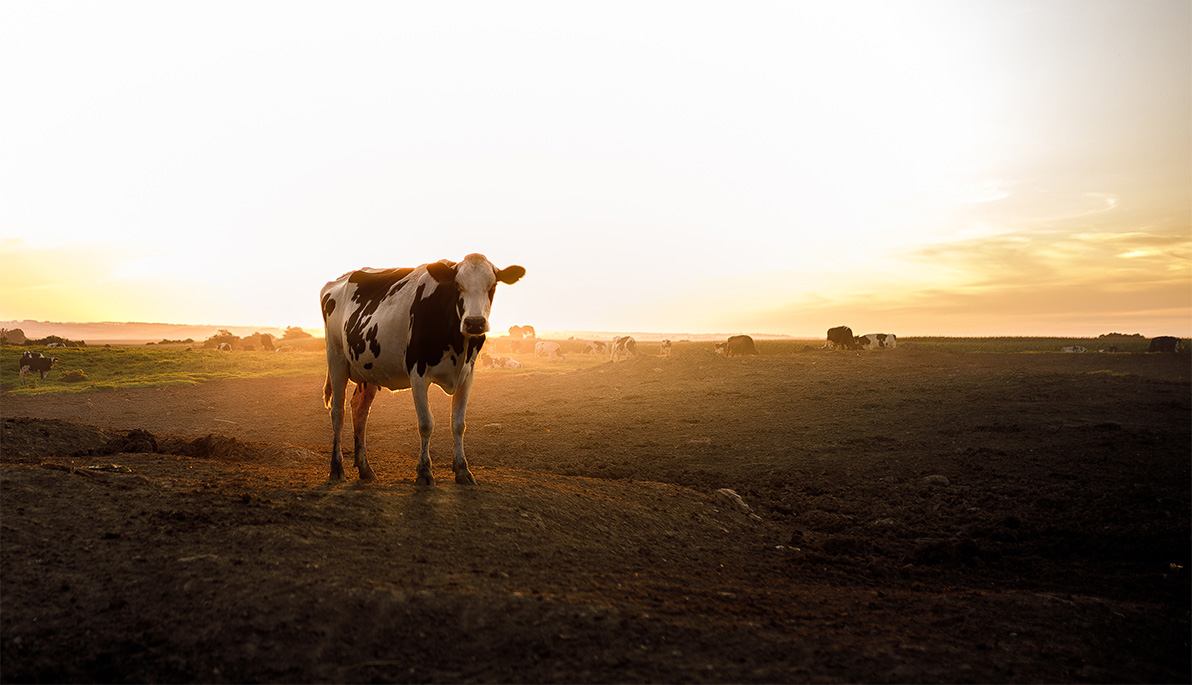News
The Planet Pays the Price: Managing Diet and Human Habitat
March 17, 2021
Pictured: Global food production, particularly animal agriculture, is the single largest driver of environmental degradation, accounting for 19 to 29 percent of climate-warming greenhouse gas (GHG) emissions globally (more than the entire transportation sector). When cows digest their food, they burp up methane.
Lorraine Mongiello, DRPH, RDN, CDE, associate professor of interdisciplinary health sciences, is worried about the earth. Fortunately, what’s good for the earth is good for the human diet, and vice versa. Unfortunately, according to Mongiello, that means humans’ poor diet choices have instigated a vicious circle: the climate gets warmer due to animal agriculture; warmer conditions and diets based on animal agriculture contribute to dangerous illness (both infectious diseases and lifestyle-based conditions like atherosclerosis and high blood pressure); and, as people resist changing their diet, the environment continues to get warmer. This is where nutritionists come in.
March is National Nutrition Month, and Mongiello is planning a trio of hard-hitting conference presentations to encourage nutritionists to keep environmental questions at the center of their professional practice. Called “The Dietary Triple Threat: COVID, Climate, and Chronic Disease,” the project ties the current pandemic to environmental conditions and lifestyle choices we can influence, individually and collectively, to make the world safer and healthier.
Diet Tied to Chronic Diseases and a Warming Earth
A diabetes specialist, Mongiello is well acquainted with the effects of a diet laden with excess calories and saturated fat. Diets rich in processed foods and animal products contribute to chronic diseases like heart disease. Most Americans know the risks—at least in theory.
Mongiello’s work points to a less obvious effect of our diet choices: the earth’s continued suitability to sustain human health. Consider the following:
- Global food production, particularly animal agriculture, is the single largest driver of environmental degradation, accounting for 19 to 29 percent of climate-warming greenhouse gas (GHG) emissions globally (more than the entire transportation sector). When cows digest their food, they burp up methane.
- In Central and South America, five million acres of rainforest per year are cut back to make room for cattle pasture. When forests are cleared to make room for farms and livestock, large stores of carbon are released into the atmosphere, which in turn heats up the planet.
- It takes 2,500 gallons of water, 12 lbs. of grain, 35 lbs. of topsoil, and the energy equivalent of one gallon of gas to produce one lb. of beef. You can feed more people with the 12 lbs. of grain, it would be healthier, and have less of an environmental impact.
- Livestock production contributes to antimicrobial resistance, another looming threat to human health.
As temperatures rise, the safety of the animal-based food supply is impacted. For example, raw chicken will go bad more quickly as salmonella will be able to reproduce more easily.

Students in Lorraine Mongiello’s nutrition class study the importance of a plant-based diet. As part of the coursework, each student prepared a meal using ingredients that are primarily unprocessed and animal-free. Student Haroon Dar cooked a healthy fish cake option.
The Environment’s Role in the Pandemic
It has become clear that those who suffer from diet-related “lifestyle diseases” are at higher risk of complications or death from COVID-19. But what about the role the environment has played in the emergence of this and other recent pandemics?
- Earth’s increasing temperatures are a factor in the emergence of infectious diseases of all kinds. According to Mongiello, “Rising temperatures have boosted the growth of bat-friendly forest habitats in China’s southern province of Yunnan and neighboring areas, making the region a hotspot for bat-borne coronavirus.” Genetic evidence indicates SARS-CoV-2 may have arisen in this area.
- 70 percent of infectious diseases have come from the natural environment, with many emerging from animal-to-human contact.
- Infectious diseases spread more easily in warmer climates and in variable weather conditions.
- People in areas with higher air pollution are at higher risk of infection and death from COVID-19.
“When we damage and overexploit wildlife and the environment, we’re leaving ourselves open to risk,” says Mongiello.
Healthcare Advice With the Planet in Mind
Mongiello acknowledges that giving health advice for Mother Earth is an unusual move for a nutritionist. “It’s not controversial that healthcare providers advocate for health policies,” she says, “but for most, their focus is on an individual patient.” Mongiello recommends that nutritionists and other health professionals look at the bigger picture.
For example, a nutritionist might recommend that a patient choose skim milk. “That’s a good individual choice,” Mongiello says, “but that fat removed from the milk is still in the food supply, and somebody is having ice cream. And all the resources used to make that ice cream are affecting the planet’s health, as well as our own health, whether or not we are the ones enjoying the ice cream.”
Patients can make everyday choices that simultaneously benefit their own health and the health of the environment, including the following suggestions:
- Try eating less of the foods with large climate footprints, like beef, lamb, and cheese. Choosing more plants and consuming less red meat and dairy will typically have the biggest impact. That doesn’t necessarily mean going vegan.
- Eat locally grown, unprocessed foods such as those available at farmers’ markets. Besides cutting down the GHG emissions from transporting food, locally grown foods increase nutrient availability and cut undernutrition and obesity.
- Reduce your food waste, both individually and through community initiatives. Thirty-two percent of food produced globally is thrown away. When left to rot in landfills, food releases about eight percent of total global GHG emissions.
- As much as possible, go places on foot or on a bicycle to reap the benefits of reduced emissions and of healthy, natural outdoor activity.
In general, Mongiello recommends including environmental sustainability “in all dietary and medical guidance.” In an ideal world, healthcare providers would monitor planetary health and communicate with individual patients about how local environmental factors, from a heatwave to a natural disaster, could affect their health.





